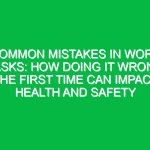Introduction
In the realm of Health, Safety, and Environment (HSE), the phrase “risk assessment for broken glass precaution” resonates with significant importance. Broken glass poses a myriad of potential hazards that can lead to injuries and accidents if not properly managed. This article delves into the vital aspects of assessing risks associated with broken glass, outlining effective precautions and strategies to mitigate these dangers in various settings, including workplaces, laboratories, and public spaces. Understanding the implications of broken glass hazards is crucial for creating safer environments and promoting a culture of safety among employees and the public alike.
Risk assessment is the systematic process of evaluating the potential risks that may be involved in a projected activity or undertaking. Within the context of broken glass, this involves identifying possible hazards, analyzing and evaluating the risks associated with those hazards, and determining appropriate ways to eliminate or control the risks. By prioritizing safety through rigorous risk assessments, organizations can reduce the likelihood of accidents and injuries, ensuring a healthier and safer environment for all.
Understanding Broken Glass Hazards
Before diving into risk assessment techniques, it’s essential to identify the various types of broken glass hazards. Broken glass can originate from multiple sources: shattered windows, broken containers, or damaged equipment. Each source presents unique risks that can lead to cuts, lacerations, or even more severe injuries. Furthermore, the presence of broken glass can create hazardous environments, particularly for vulnerable populations such as children or the elderly.
Several key factors influence the risk associated with broken glass:
- Type of Glass: Different types of glass, such as tempered glass or regular glass, have varying levels of fragility and potential for injury.
- Location: The setting in which broken glass occurs—whether in a manufacturing facility, a healthcare environment, or a public space—significantly impacts the level of risk.
- Accessibility: Areas where broken glass is more accessible to individuals heighten the risk of injury, necessitating thorough precautions.
Key Components of Risk Assessment for Broken Glass Precautions
An effective risk assessment for broken glass precaution encompasses several critical components, each contributing to a comprehensive safety strategy. Below are the fundamental elements of such an assessment:
1. Identification of Hazards
The first step involves identifying all potential sources of broken glass. This includes routine inspections of areas where glass is utilized, such as laboratories, kitchens, and construction sites. Engaging employees in this process can help uncover hidden hazards that might otherwise be overlooked.
2. Risk Analysis
Once hazards are identified, the next step is analyzing the risks associated with them. This involves determining the likelihood of an injury occurring due to broken glass and assessing the potential severity of those injuries. Utilizing a risk matrix can aid in visualizing and categorizing risks from low to high.
3. Implementation of Control Measures
After analyzing the risks, organizations must implement appropriate control measures to mitigate these risks. This might include:
- Providing personal protective equipment (PPE) like gloves and safety goggles.
- Enhancing storage and handling procedures for glass items.
- Installing safety barriers or signs to warn of broken glass hazards.
4. Training and Awareness
An often-overlooked aspect of risk assessment is the need for training and awareness among employees. Conducting regular training sessions on the proper handling of glass and emergency procedures for dealing with broken glass incidents can empower individuals to act effectively and safely.
5. Monitoring and Review
Finally, risk assessment is not a one-time process. Regular monitoring and review of the risk assessment and control measures are essential to ensure their effectiveness over time. This includes revisiting the assessment after any incident involving broken glass to evaluate what went wrong and how similar incidents can be prevented in the future.
Best Practices for Broken Glass Precautions in HSE
Incorporating best practices into the risk assessment process for broken glass can further enhance safety measures. Here are some actionable insights that organizations can adopt:
- Use of Safety Glass: Whenever feasible, opt for safety glass or tempered glass, which is less prone to shattering.
- Immediate Cleanup: Establish protocols for the immediate cleanup of broken glass, ensuring all employees are trained in safe cleanup techniques.
- Regular Inspections: Conduct routine inspections of areas where glass is present, and address any potential hazards before they become risks.
- Incident Reporting System: Implement a robust incident reporting system to track injuries related to broken glass and analyze trends over time.
Real-Life Example of Risk Assessment Implementation
To illustrate the importance of risk assessment for broken glass precautions, consider the case of a manufacturing facility where glass containers are used for product storage. Following a series of minor injuries from employees handling broken glass, the management team decided to conduct a thorough risk assessment.
The assessment process revealed that the primary risks stemmed from improper handling techniques and insufficient protective equipment. In response, management instituted mandatory training sessions on proper lifting and handling techniques, introduced a policy requiring the use of cut-resistant gloves when handling glass, and installed designated glass disposal containers throughout the facility.
As a result of these proactive measures, the facility reported a significant decrease in injuries related to broken glass within six months. This case exemplifies the effectiveness of risk assessment in identifying hazards and implementing suitable precautions, ultimately creating a safer work environment.
Regulations and Standards Governing Broken Glass Safety
In the HSE domain, several regulations and standards guide the assessment and management of risks associated with broken glass. Familiarizing oneself with these regulations is crucial for compliance and safety. Key regulations include:
- Occupational Safety and Health Administration (OSHA): OSHA sets forth standards that require employers to provide a safe working environment, including the management of hazards like broken glass.
- National Institute for Occupational Safety and Health (NIOSH): NIOSH provides research and recommendations for workplace safety, including guidelines on handling glass safely.
- ISO 45001: This international standard for occupational health and safety management systems emphasizes the need for risk assessment and the establishment of a safe workplace.
Compliance with these regulations not only helps organizations avoid legal repercussions but also fosters a culture of safety that can enhance employee morale and productivity.
Conclusion
The critical risk assessment for broken glass precautions is an essential aspect of ensuring health and safety in various environments. By systematically identifying hazards, analyzing risks, implementing control measures, and fostering a culture of safety through training, organizations can significantly reduce the likelihood of injuries related to broken glass.
The importance of prioritizing safety extends beyond mere compliance with regulations; it reflects a commitment to protecting employees, customers, and the community at large. As we navigate environments that utilize glass, it is paramount to remain vigilant and proactive in assessing risks and implementing robust safety measures. In doing so, we not only safeguard individuals but also contribute to a sustainable and safety-conscious culture.


